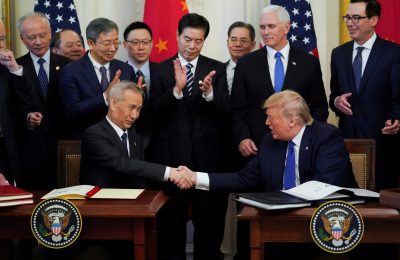China
Trump’s trade deal poses new dangers to Southeast Asia

Author: Calvin Cheng, ISIS Malaysia
After two years of alternating between tense escalation and fleeting periods of calm, the United States and China reached a preliminary phase one trade deal in December 2019. Government spokespersons in both countries promptly cheered the signing of the agreement — but observers around the world remain a little more circumspect.
The primary achievement of the phase one deal seemed to be tempering the uncertainty of further tariff escalation, with both sides agreeing to cancel their upcoming tariff hikes. But it ultimately does very little to improve things in the immediate term. The agreement did not remove existing tariffs on more than US$500 billion of US–China bilateral trade.
Discussions on the thorniest issues like state subsidies have been put off and left to a future ‘phase two’ agreement. Trade watchers also raise concerns about the purchase component of the deal that requires China to buy US$200 billion more US products over the next two years. The full text of the agreement specifically lists approximately 549 products at the HS 4-digit level for China to buy from the United States — covering agriculture, manufacturing and energy-related products.
Some of these concerns revolve around the ability of China to make good on its commitments to increase purchases from the United States amid lofty US purchase targets and rising risks to Chinese economic growth. But perhaps the more serious concern lies in the United States’ shift towards managed trade. Forcibly tying Chinese import requirements to the trade deal risks violating global trading rules, distorting and diverting world trade.
And here lies the crux of the problem. This kind of distortion and diversion threatens to create a new source of gloom for exporters in Southeast Asia, as China’s increase in US goods imports will likely come at the expense of other countries in the region.
Recent analysis suggests that agriculture exporters like Brazil, the European Union, Australia and New Zealand may see declines in Chinese agriculture demand as it buys more US produce. Similarly, non-US sources of manufactured goods like the European Union, Japan and South Korea may also be affected, while the energy-related products on the list would likely affect commodity exporters in the Gulf as well as Australia.
Countries in the Southeast Asian region may not be spared. Of the main exporting economies in the region, ISIS Malaysia estimates suggest that Malaysia remains the country with the highest exposure. US$52.7 billion worth — about 83 per cent — of Malaysian exports to China are of products similar to the 549 products listed in the phase one purchase agreement and thus at risk of losing market share to US producers.
Separated into broad product classes, Malaysian exports of four categories could be the most vulnerable — electronics and electrical parts and equipment; food and beverage-related products; industrial chemicals and metals; and energy-related products like petroleum and palm oil.
Looking deeper into specific product types — and filtering for products the United States has a sizeable market share of — the data indicates that Malaysia’s exports of chemicals compounds such as rare-earth metals, organo-sulphur compounds, ethyl alcohol and acids appear particularly susceptible. Food-related products like vegetable oils, cocoa and coffee products and sugar confectionery also appear to be at risk.
The Philippines and Singapore are the next most-exposed economies in Southeast Asia, with 82 per cent and 66 per cent of exports to China affected by the phase one purchase agreement, respectively. In the Philippines, at-risk products are primarily in agricultural commodities like coconut products, fruit and nuts. In Singapore, at-risk products span refrigerators and disk drives, industrial chemicals like phenols, petroleum oils and organic compounds.
Vietnam and Thailand are relatively less exposed, with less than 65 per cent of exports to China affected by the purchase agreement in the phase one deal. Still, Vietnamese exporters of cereals, vegetable and fish products should be wary, as should Thai exporters of industrial chemicals and vegetable products.
While this phase one deal does ease anxieties surrounding further trade escalations between the United States and China, it also brings new risks and fresh unknowns. In any case, trade protectionism and tariffs have become the new normal.
Since the beginning of the year alone, US President Donald Trump has broadened Section 232 national…
China
Is journalist Vicky Xu preparing to return to China?

Chinese social media influencers have recently claimed that prominent Chinese-born Australian journalist Vicky Xu had posted a message saying she planned to return to China.
There is no evidence for this. The source did not provide evidence to support the claim, and Xu herself later confirmed to AFCL that she has no such plans.
Currently working as an analyst at the Australian Strategic Policy Institute, or ASPI, Xu has previously written for both the Australian Broadcasting Corporation, or ABC, and The New York Times.
A Chinese language netizen on X initially claimed on March 31 that the changing geopolitical relations between Sydney and Beijing had caused Xu to become an expendable asset and that she had posted a message expressing a strong desire to return to China. An illegible, blurred photo of the supposed message accompanied the post.
This claim was retweeted by a widely followed influencer on the popular Chinese social media site Weibo one day later, who additionally commented that Xu was a “traitor” who had been abandoned by Australian media.
Following the publication of an ASPI article in 2021 which exposed forced labor conditions in Xinjiang co-authored by Xu, the journalist was labeled “morally bankrupt” and “anti-China” by the Chinese state owned media outlet Global Times and subjected to an influx of threatening messages and digital abuse, eventually forcing her to temporarily close several of her social media accounts.
AFCL found that neither Xu’s active X nor LinkedIn account has any mention of her supposed return to China, and received the following response from Xu herself about the rumor:
“I can confirm that I don’t have plans to go back to China. I think if I do go back I’ll most definitely be detained or imprisoned – so the only career I’ll be having is probably going to be prison labor or something like that, which wouldn’t be ideal.”
Neither a keyword search nor reverse image search on the photo attached to the original X post turned up any text from Xu supporting the netizens’ claims.
Translated by Shen Ke. Edited by Shen Ke and Malcolm Foster.
Asia Fact Check Lab (AFCL) was established to counter disinformation in today’s complex media environment. We publish fact-checks, media-watches and in-depth reports that aim to sharpen and deepen our readers’ understanding of current affairs and public issues. If you like our content, you can also follow us on Facebook, Instagram and X.
Read the rest of this article here >>> Is journalist Vicky Xu preparing to return to China?
China
Guide for Foreign Residents: Obtaining a Certificate of No Criminal Record in China

Foreign residents in China can request a criminal record check from their local security bureau. This certificate may be required for visa applications or job opportunities. Requirements and procedures vary by city. In Shanghai, foreigners must have lived there for 180 days with a valid visa to obtain the certificate.
Foreign residents living in China can request a criminal record check from the local security bureau in the city in which they have lived for at least 180 days. Certificates of no criminal record may be required for people leaving China, or those who are starting a new position in China and applying for a new visa or residence permit. Taking Shanghai as an example, we outline the requirements for obtaining a China criminal record check.
Securing a Certificate of No Criminal Record, often referred to as a criminal record or criminal background check, is a crucial step for various employment opportunities, as well as visa applications and residency permits in China. Nevertheless, navigating the process can be a daunting task due to bureaucratic procedures and language barriers.
In this article, we use Shanghai as an example to explore the essential information and steps required to successfully obtain a no-criminal record check. Requirements and procedures may differ in other cities and counties in China.
Note that foreigners who are not currently living in China and need a criminal record check to apply for a Chinese visa must obtain the certificate from their country of residence or nationality, and have it notarized by a Chinese embassy or consulate in that country.
Foreigners who have a valid residence permit and have lived in Shanghai for at least 180 days can request a criminal record check in the city. This means that the applicant will also need to currently have a work, study, or other form of visa or stay permit that allows them to live in China long-term.
If a foreigner has lived in another part of China and is planning to or has recently moved to Shanghai, they will need to request a criminal record check in the place where they previously spent at least 180 days.
There are two steps to obtaining a criminal record certificate in Shanghai: requesting the criminal record check from the Public Security Bureau (PSB) and getting the resulting Certificate of No Criminal Record notarized by an authorized notary agency.
This article is republished from China Briefing. Read the rest of the original article.
China Briefing is written and produced by Dezan Shira & Associates. The practice assists foreign investors into China and has done since 1992 through offices in Beijing, Tianjin, Dalian, Qingdao, Shanghai, Hangzhou, Ningbo, Suzhou, Guangzhou, Dongguan, Zhongshan, Shenzhen, and Hong Kong. Please contact the firm for assistance in China at china@dezshira.com.
China
China Unveils Plan to Upgrade Industrial Equipment

China unveiled a comprehensive action plan for upgrading industrial equipment, with a focus on driving technological innovation and economic growth. The plan, released on April 9, 2024, aims to enhance competitiveness and sustainability within the manufacturing sector through extensive investment and regulatory support.
China announced an ambitious action plan for industrial equipment upgrading, which aims to drive technological innovation and economic growth through extensive investment and regulatory support.
On April 9, 2024, China’s Ministry of Industry and Information Technology (MIIT) and six other departments jointly released a notice introducing the Implementation Plan for Promoting Equipment Renewal in the Industrial Sector (hereafter referred to as the “action plan”).
Finalized earlier on March 23, 2024, this comprehensive action plan addresses critical issues related to technological innovation and economic development. It reflects China’s proactive stance in enhancing competitiveness and sustainability within its manufacturing sector. The initiative underscores the recognition of industrial equipment upgrading as a top policy priority.
The scope of China’s action plan to upgrade industrial equipment in manufacturing, is extensive, covering various aspects such as:
In line with China’s ambitious goals for industrial modernization and sustainable development, the action plan outlines several key objectives aimed at driving substantial advancements in the industrial sector by 2027.
These objectives encompass a wide range of areas, from increasing investment to enhancing digitalization and promoting innovation, including:
The objectives and key actions proposed in the action plan are summarized below.
This article is republished from China Briefing. Read the rest of the original article.
China Briefing is written and produced by Dezan Shira & Associates. The practice assists foreign investors into China and has done since 1992 through offices in Beijing, Tianjin, Dalian, Qingdao, Shanghai, Hangzhou, Ningbo, Suzhou, Guangzhou, Dongguan, Zhongshan, Shenzhen, and Hong Kong. Please contact the firm for assistance in China at china@dezshira.com.






